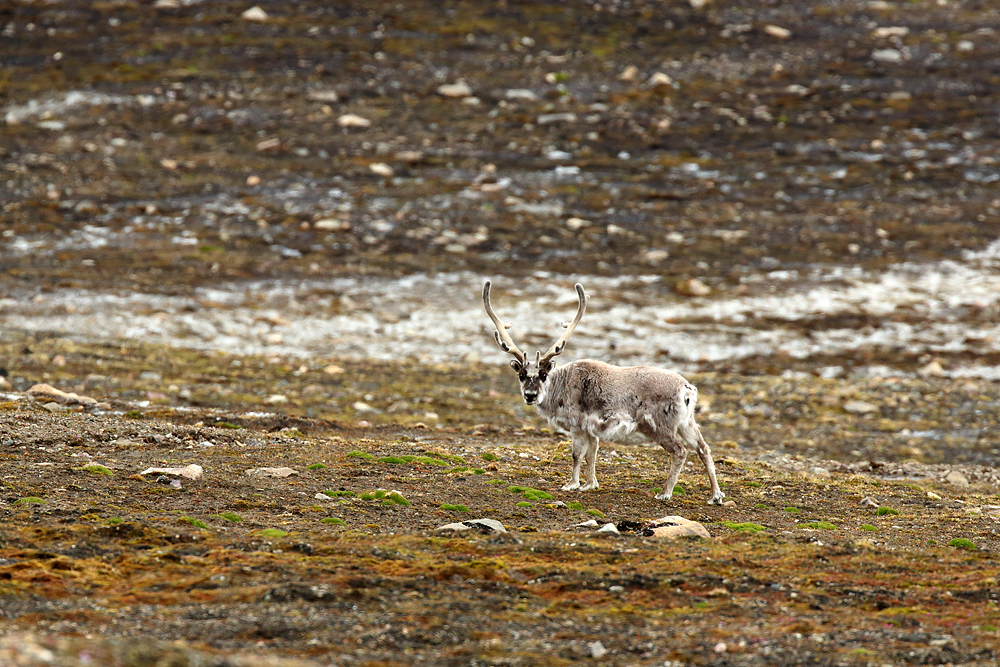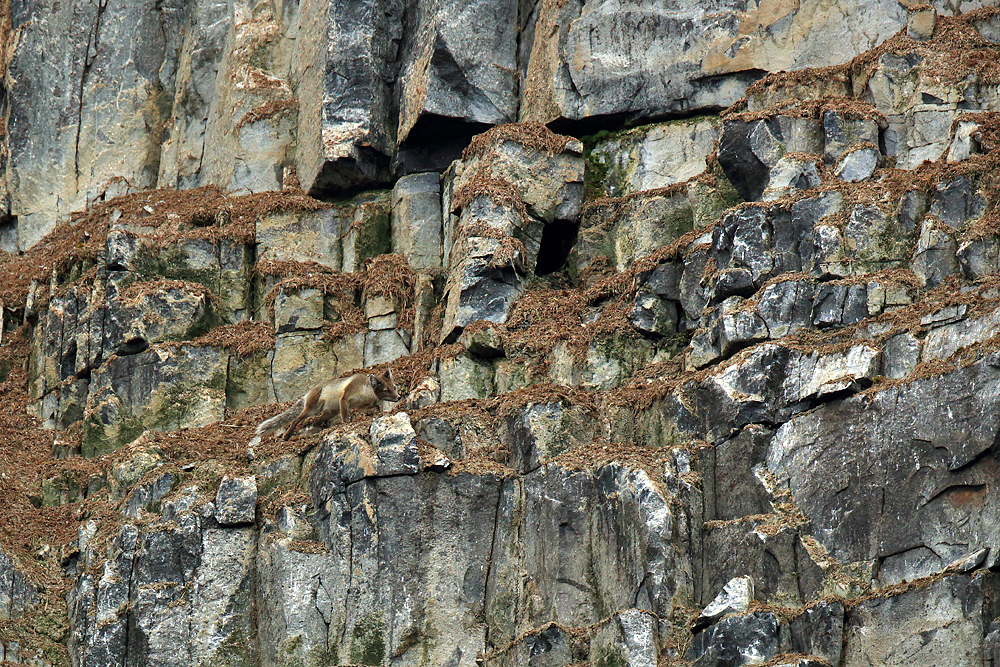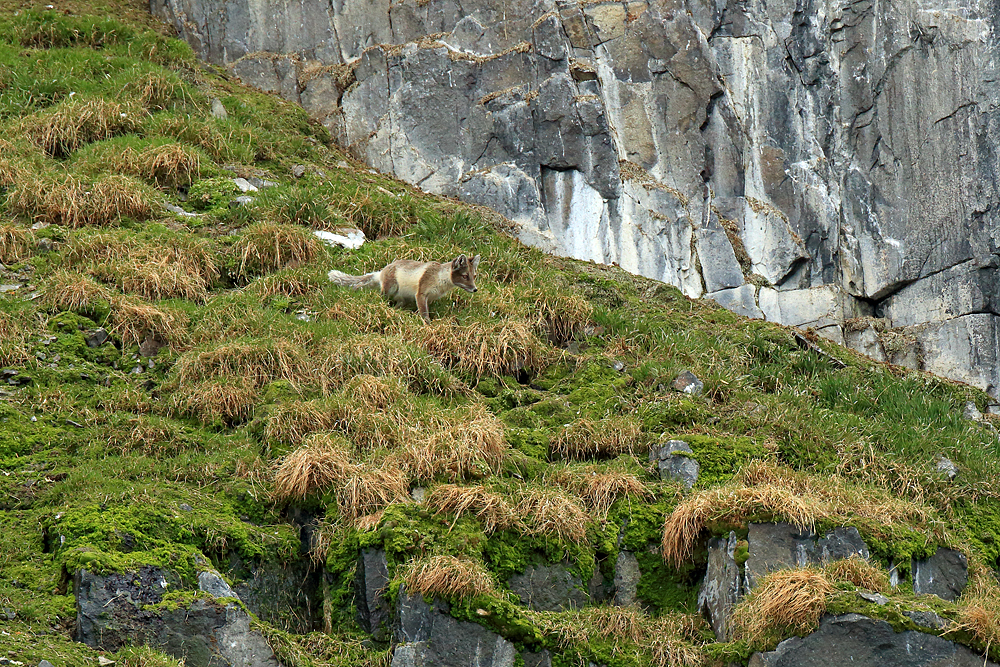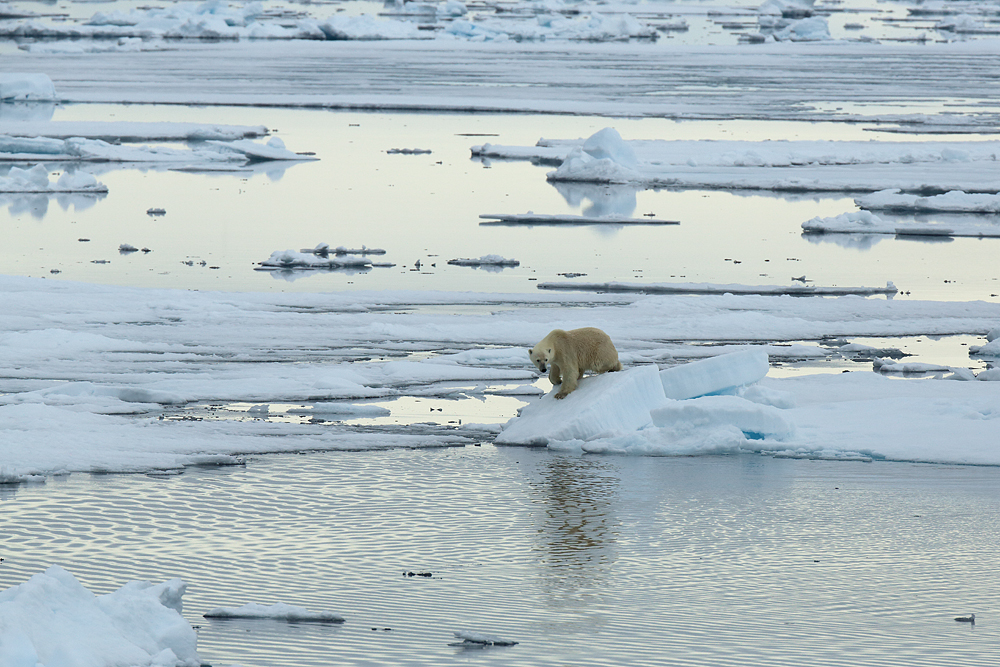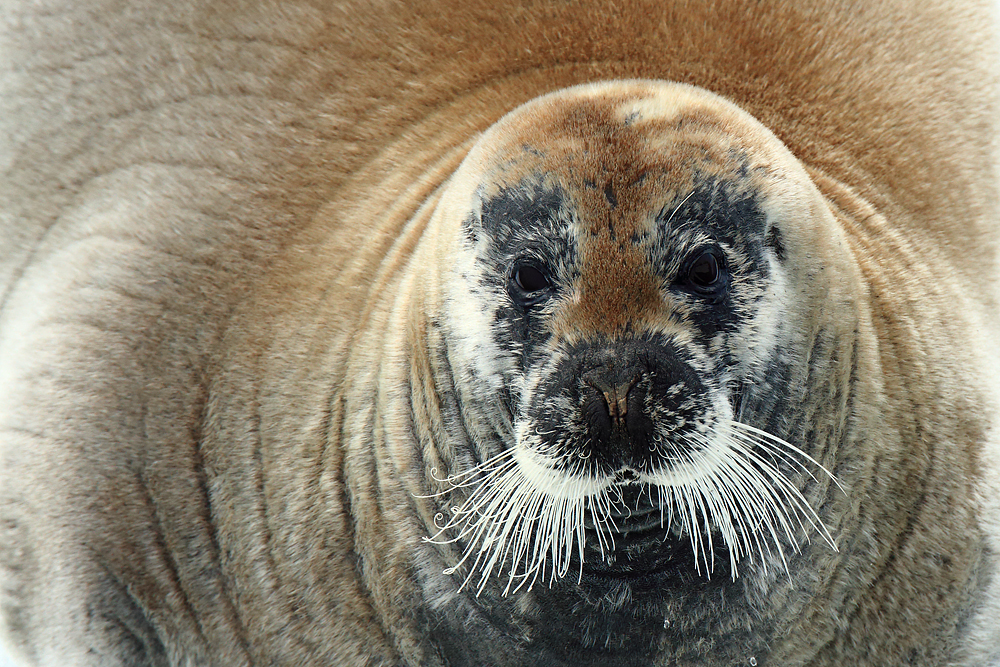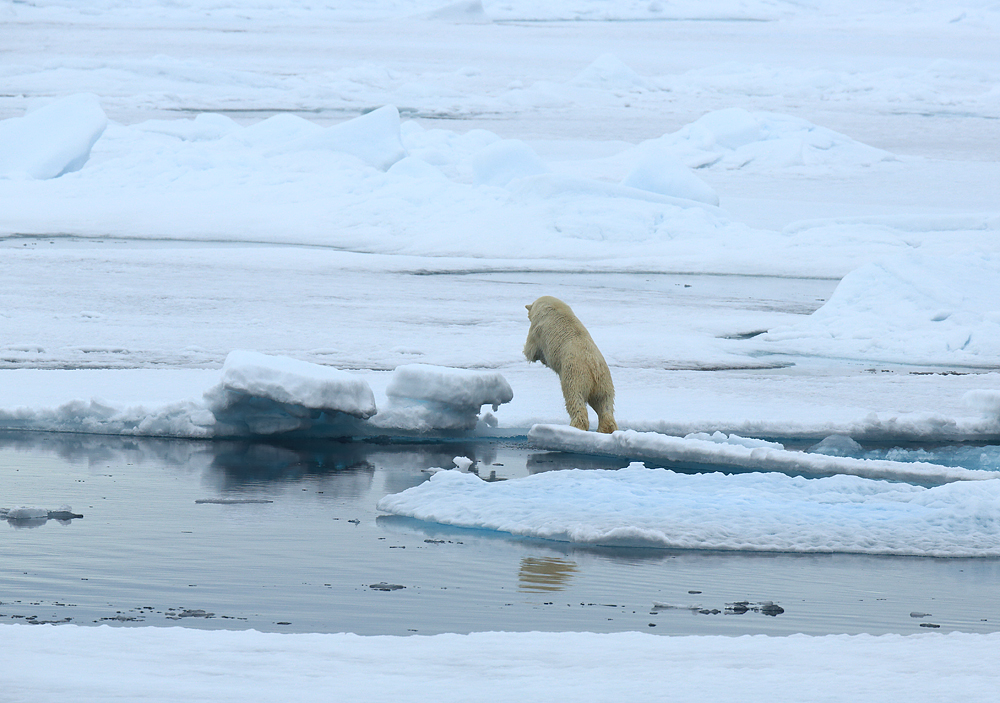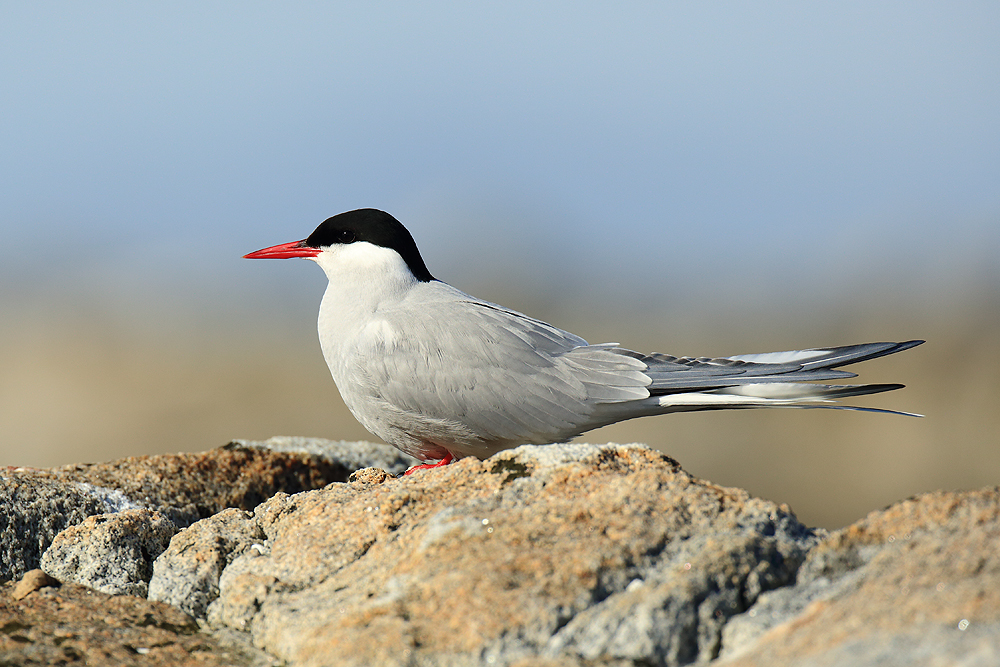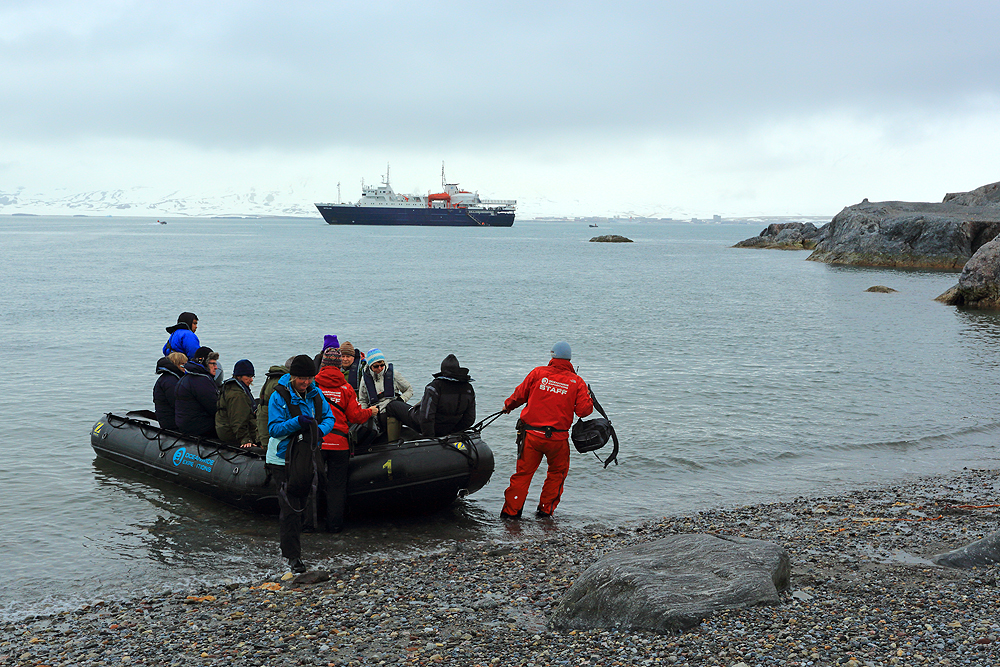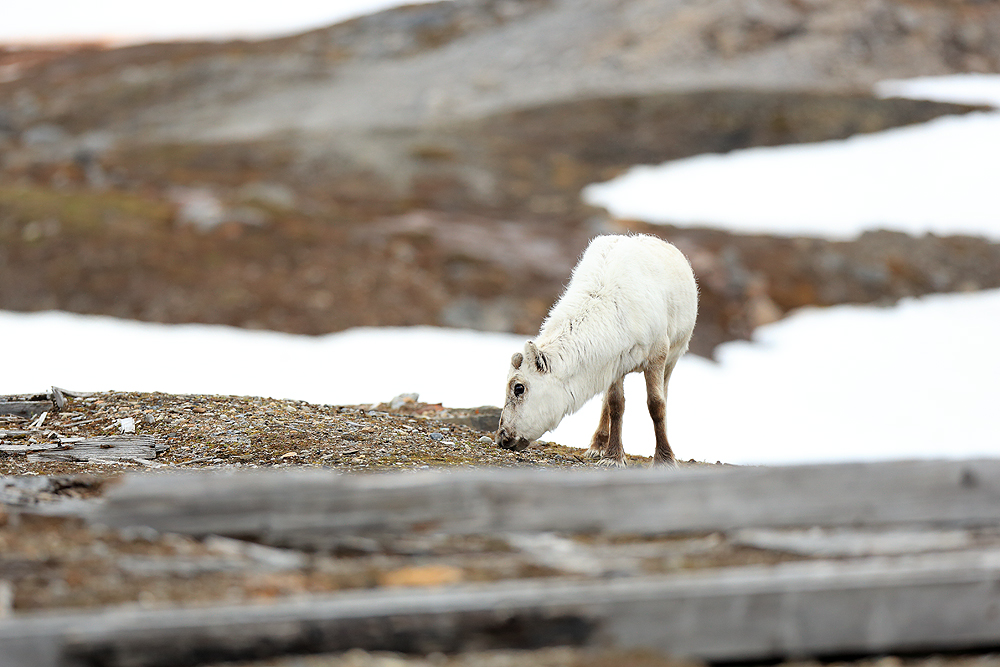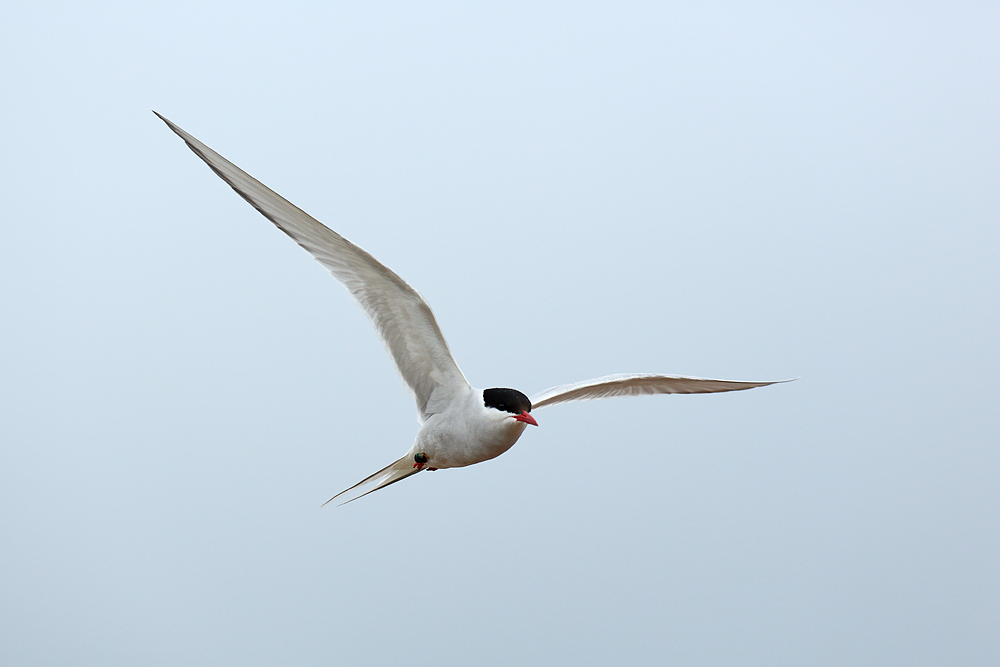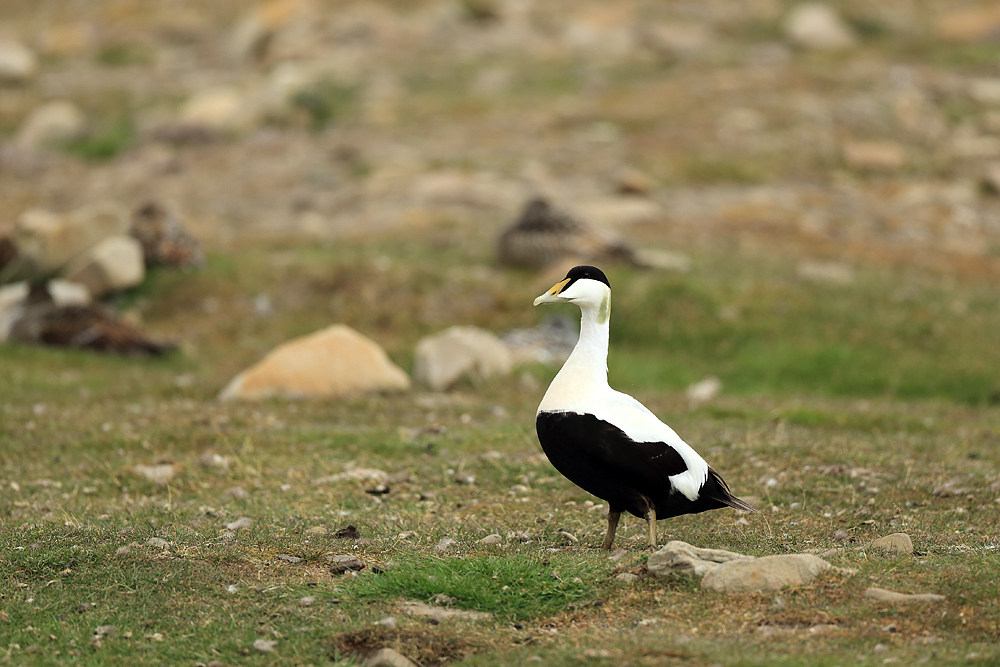|
Having had two Polar Bear sightings in as many days the morale was high among the group but sadly our planned excursion to find the Walrus haulout was a no go. It seemed that nobody was at home and so we moved on to the fhord at Faksevagen. Here we went off on our first proper walk to explore the Arctic Tundra. We set off with our Norwegian guide Stein and headed up the hillside into the slight mist. Stein was completely relaxed and didn't seem at all worried by the possibility of any bears. We spotted a few Reindeer here and there but they all seemed to keep their distance from us, suddenly we had company ... a Purple Sandpiper. The bird blended in superbly well with the tundra and you can see why they breed in this terrain. Then at long last the Reindeer came close enough for me to get a few shots, including the lovely male below which had a great set of antlers. As we walked along the edge of a shallow ridge line we suddenly saw a white animal appear within only a few yards of us. Your reaction says Polar Bear but luckily it was only another Reindeer, and luckily for me he posed nicely for a few photographs too. At the top of the ridge we had a sighting of the ship surrounded by an ice floe that had been at least half a kilometre away when we landed. It just goes to show how quickly the environment can change in this amazing landscape. We headed back to the ship for yet another filling lunch before we headed to the amazing breeding colony of Brunnich's Guillemots at Alkefjellet. We were told to dress warmly as we were going to be on the Zodiacs for at least a couple of hours and possibly more depending on the quality of the sightings. We went out onto the water in our Zodiacs and I had our Austrian guide Barbara (an expert on Glaciers). We made our way slowly towards the cliffs and at first there were just a few hundred birds on the tiny rocky outcrops, where each bird was incubating a solitary egg. However, as we made our way further along the cliffs, away from the ship the sky seemed to be filled with birds. The cliffs were towering above us, stained a mix of white and pink from the guillemots' droppings, and the birds were there in their thousands. The noise was quite amazing and it was an incredible spectacle which I feel truly honoured to have seen. We were desperate to see our first Arctic Fox at Alkefjellet and when we came to a grass covered scree slopes it was the best chance we would have. We scanned and we scanned but we just couldn't see any movement ... then Barbara spotted one, our first Arctic Fox. She was so excited and we were too, it was a long way off but it was an amazing sighting. We eventually decided to leave the fox alone and head back to the ship for the evening and yet another meal. Tonight we were heading to a fjord that has only be visited by a handful of vessels, even our expedition leader had never been there before. We were now really on a true Arctic expedition and heading into the unknown.
0 Comments
Having spent the night in the ice, all was clear on the Polar Bear front but we weren't to be put off. Today we were going to head through the ice and see if we could find some more bears. After breakfast we were to have a lecture about how to sex Polar Bears, as the lecture was coming to an end a call went out over the loud speaker ... a Polar Bear was on the horizon. We made our way towards the bear and this bear seemed more relaxed in our presence but as we approached a group of Harp Seal swam around the ship's bow. It was amazing to get closer to this bear and see it behave as if we weren't even there ... After 45 minutes or so we decided to leave the bear in peace as we didn't want to break the ice and destroy its potential hunting habitat. We set off through one of the many clear channels in the ice and headed east along the coast of northern Spitsbergen. As we made our way through the ice we disturbed the water and were therefor accompanied by Fulmars, Kittiwakes and Glaucous Gulls. I went to the stern of the ship and photographed these birds as they performed their aerobatics. As we kept on heading through the ice to the remote island of Moffen we noticed a large lump on the ice, it was a Walrus ... our first of the trip! As we got closer, much to our dismay, the Walrus slipped off into the icy water and out of sight. We were all a little disappointed but then to our delight we noticed a multiple of lumps, yet more Walruses. It was a bachelor group of Walrus, sitting on a small ice floe and creating quite a mess in the process. The ice was less than pristine but the Walruses certainly seemed content as the captain swung the ship to try and make sure everyone on board got a great view. So with Walrus finally ticked off and some close relatively close encounters from the lowest point on the ship we headed off towards one of the fjords where we hoped to land the following morning. The target ... yet more Walruses but this time at a well known haul-out point.
Having had an action-packed day in the High Arctic does not necessarily mean that the day is done and bed is soon to follow. With 24 hour daylight a wildlife sighting could happen at any time and the camera always needs to be kept close by (in my case it went pretty much everywhere with me except to the dining room). Today was definitely a day when the wildlife watching didn't stop after dinner, in fact were above 80 degrees North and we were in the pack ice. The excitement of being surrounded by ice had led many of the group to head out on deck and to the bow of the ship and start to scan the horizon for the mammal everyone had come to see ... the Polar Bear. As we were often reminded anywhere in Spitsbergen could be the temporary home of a Polar Bear, even in the far South of the Island. The weather had gone on the gloomy side again after a glorious few hours of Arctic sun but we were not deterred and we were all scanning. In the mist we noticed a large 'blob' on a small piece of ice, it was so large in fact that for a while we thought there must have been more than one mammalian being in this 'blob'. As we got closer and the mist cleared a little we realised that this was in fact just one large piece of blubber. It was an incredibly obliging Bearded Seal, you would not believe that animal would allow a large ice-breaking vessel to steam right up towards it, only metres away, but it did just that! So having spent a good 20 minutes with the seal we decided that it should be left alone, having an ice-strengthened ship is probably not a seal's favoured company. The ship carried on through the ice field, trying to avoid the worst of the ice by using the natural channels that form due to the currents and tides. As we continued onwards into the night there were more than 30 people on the ships bow continually scanning and enjoying the evening light when suddenly there was a shout ... "Bear, Polar Bear!". And sure enough, on the horizon, due North, there was a cream coloured lump among what seemed a sea of ice. The crew turned the ship straight towards the bear and the excitement and buzz that everyone was feeling was very apparent. The slight tension (only slight) that was felt before had evaporated and everyone was there with a smile on their face. As we approached the bear we noticed that it was watching a seal on the ice and was slowly making its way towards the black blob (there were a lot of blobs on the voyage). We spent what seemed an eternity trying to get closer to the bear, with success, but it soon became clear that this bear did not want company and we eventually decided to call it a night. As the Polar Bear off towards the icy horizon we were told that the ship would be spending the night in the ice and that we would set sail again in the morning. With our first sighting of this truly stunning mammal it was time to head to bed and hope that tomorrow would bring us further sightings. After all, we had now all been bitten by the Polar Bear bug.
Today we awoke to some truly stunning scenery to the East and a shroud of mist to the West, the next land stop ... Greenland. We were working our way North to the High Arctic and aiming to visit a Little Auk colony (something I have always wanted to do). These little birds are superbly charismatic and fly in flocks of a few hundred to a few thousand, the colony easily numbered over 50,000 and it was absolutely breathtaking. We arrived on shore, after another short Zodiac transfer, before arriving to the superb guides who were already checking out for Polar Bears. We were greeted by a pair of Arctic Skuas before the numbers of the group grew too big and eventually they flew off to the refuge of the rocky cliffs. We then slowly made away across the rocky scree slope towards the little Auks and the next couple of hours went so so quickly. I could have stayed all day long and photographed these wonderful birds but before I was even settled it was time to head back to the ship. Having packed some of the camera gear away I looked at my watch and realised a couple of hours had passed, it seemed like not time at all. This afternoon there was to be no landing, instead we were to go on a Zodiac cruise from the Ortelius towards a glacier edge. As we boarded the Zodiacs the sun came out, the mist started to clear and we were soon surrounded by an intense blue with the white snowfields and snow-capped mountains. As we started to make our way down this beautiful Arctic fjord we spotted a distant rock moving, as rocks obviously don't move we knew that we must have a seal ... we certainly did, our first Harbour Seal (Common Seal). We daren't approach too closely in case we scared it off so we made sure we left it alone after capturing a few record shorts. The ice in the fjord, which had broken off from the glacier, littered the water and the Zodiac was forced to weave in and out to avoid the larger pieces. We then came across a posing Black Guillemot silhouetted upon the top of small piece of ice as well as a swimming and rather wary of us. The landscapes were just absolutely stunning and I really hope some of the images do it at least a little justice. We also came across an individual Arctic Tern sunning itself in the warm afternoon sun. The Arctic, at this time of year, has 24 hours worth of daylight and that means the wildlife watching doesn't stop after dinner, in fact sometimes the best sightings are when you are getting ready for bed. This was just the first half of our day with plenty more to come ...
With our first night at sea, we were up bright and early for the first of many amazing breakfasts before a briefing on our first Zodiac excursion. This morning we were visiting an area where a historic British marble quarry once operated but is now favoured by Svalbard Reindeer and Long-tailed Skua. This was our first landing and so it was our first time venturing into Polar Bear territory. In fact, it turns out that anywhere on land is bear country as is anywhere at sea! We quickly spotted our first Svalbard Reindeer and we managed to get a few photographs in the gloom of the morning. As we walked across the tundra for the first time we saw plenty of Snow Bunting, our first Red-throated Diver, Long-tailed Duck, Purple Sandpiper, Brent Geese and the stunning Long-tailed Skua! We had a great introduction to the Arctic ecosystem in the morning with our visit to Ny London before having a superb lunch (in fact all the food throughout the trip was just "fantastic"). In the afternoon we would be visiting the northerly town of Ny Alesund where there are breeding Arctic Tern and sometimes some Arctic Foxes, the small settlement is primarily a research centre having originally been built for a coal mine but it is also home to the world's most northerly post office! It was the wildlife that was to feature and we had another yet another Zodiac transfer to the small dock and we were then free to wander (with a perimeter of armed guards around the settlement). A great day all round and a really educational first full day in the Arctic. We knew that tomorrow would be our first day in the "High Arctic" and we were all very excited indeed. Another night's worth of cruising and we would start to be in a really wild landscape!
Where do I begin ... well let's say that I was very lucky to be offered a place on Naturetrek's Spitsbergen cruise, with the staff discount, with only a couple of weeks notice. Of course I jumped at the chance and flew out to Oslo before heading to the Arctic Circle, I could not believe it was all happening. Anyway upon arrival on the island of Spitsbergen, in the charismatic and rather cold town of Longyearbyen, we awaited to board our ship an so I headed off with my colleague Simon to find some local wildlife. It wasn't long before we were being dive-bombed by breeding Arctic Terns, for such small birds this is truly quite disconcerting. As well as the terns there was also a breeding colony of Common Eider (ducks) all nesting in this cool Arctic habitat. So without further ado, here are a selection of images from that afternoon before we headed to our vessel for the trip ... M/V Ortelius. (The light was pretty gloomy so the images are mere record shots.) We boarded the Ortelius, our home for the next seven nights, and attended the mandatory safety demonstrations and drills. It was then time to head out on deck and start our wildlife watching with binoculars and cameras at the ready, we were keen and expectations were high all round. We were followed, almost instantly, by Fulmars (which follow the ship for the possibility of an easy meal) and these provided some challenging but fun photographic subjects. We were only a couple of hours in when the shout went out for whale and sure enough, there were a small group of whales on the horizon. They weren't just any whales ... they were a group of Blue Whale!!!!! So what a first day, I have always wanted to see a Blue Whale and I never expected to see them on this trip. So after staying up until nearly midnight and still have perfect light I made the brave decision to go to bed. The night was uneventful and so I slept through until the next morning where we would go for our first Zodiac excursions.
|
AuthorBret Charman Archives
July 2024
Categories
All
|


